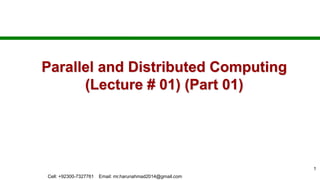
Lecture 01 - Chapter 1 (Part 01): Some basic concept of Operating System (OS), Parallel & Distributed Computing
- 1. Parallel and Distributed Computing (Lecture # 01) (Part 01) 1 Cell: +92300-7327761 Email: mr.harunahmad2014@gmail.com
- 2. Instructor Information Name: Muhammad Haroon (MSCS from BZU) (PhD Scholar in Computer Science from HITEC University) Contact information: mr.harunahmad2014@gmail.com Domain: Machine Learning, Artificial Intelligence, Deep Learning, Data Science, Image Processing, Computer Vision, Natural Language Processing, Mobile Apps, Websites
- 3. Course Information Name Parallel and Distributed Computing Lectures 16 Quizzes 10 Assignments 10 Attendance 75% Semester Report + Project +Presentation 01 Note: The plagiarism & cheating cases would be reported to the Disciplinary Committee.
- 4. Classroom rules Don’t Ask for leave Ask for quiz re-take Ask for assignment re-submit Ask for mobile call Ask for break 20 minutes break
- 5. Overview of Course At the end of the course the students will be able to: Write portable programs for parallel or distributed architectures using Message-Passing Interface (MPI) library Analytical modelling and performance of parallel programs. Analyze complex problems with shared memory programming with openMP. 5 Cell: +92300-7327761 Email: mr.harunahmad2014@gmail.com
- 6. DISTRIBUTED SYSTEMS Principles and Paradigms (Lecture # 01) 6 Cell: +92300-7327761 Email: mr.harunahmad2014@gmail.com
- 7. What is an Operating System An operating system is: A collection of software components that Provides useful abstractions and Manages resources to Support application programs, and Provide an interface for users and programs 7 Cell: +92300-7327761 Email: mr.harunahmad2014@gmail.com
- 8. Operating System Functions An operating system’s main functions are to: Schedule processes & multiplex CPU Provide mechanisms for IPC and synchronization Manage main memory Manage other resources Provide convenient persistent storage (files) Maintain system integrity, handle failures Enforce security policies (e.g., access control) Give users and processes an interface 8 Cell: +92300-7327761 Email: mr.harunahmad2014@gmail.com
- 9. Definition of a Distributed System (1) A distributed system is (Tannenbaum): A collection of independent computers that appears to its users as a single coherent system. A distributed system is (Lamport): One in which the failure of a computer you didn't even know existed can render your own computer unusable 9 Cell: +92300-7327761 Email: mr.harunahmad2014@gmail.com
- 10. Properties of Distributed Systems Concurrency Multicore systems Multiple hosts No global clock Theoretical impossibility Expense of accurate clocks Independent view Message delay, failure Impossible to distinguish slow vs. failed node Independent failure Message delivery (loss, corruption) Nodes (fail-stop) 10 Cell: +92300-7327761 Email: mr.harunahmad2014@gmail.com
- 11. Software Concepts An overview of NOS (Network Operating Systems) DOS (Distributed Operating Systems) Middleware System Description Main Goal DOS Tightly-coupled operating system for multi- processors and homogeneous multicomputers Hide and manage hardware resources NOS Loosely-coupled operating system for heterogeneous multicomputers (LAN and WAN) Offer local services to remote clients Middleware Additional layer atop of NOS implementing general-purpose services Provide distribution transparency
- 12. Definition of a Distributed System (2) Figure 1-1. A distributed system organized as middleware. The middleware layer extends over multiple machines and offers each application the same interface.
- 13. Transparency in a Distributed System Figure 1-2. Different forms of transparency in a distributed system (ISO, 1995). Other forms: Parallelism – Hide the number of nodes working on a task Size – Hide the number of components in the system Revision – Hide changes in software/hardware versions
- 14. Challenges Performance Concurrency Failures Scalability System updates/growth Heterogeneity Openness Multiplicity of ownership, authority Security Quality of service/user experience Transparency Debugging
- 15. Approaches Virtual clocks Group communication Heartbeats/failure detection, group membership Distributed agreement, snapshots Leader election Transaction protocols Redundancy, replication, caching Indirection - naming Distributed mutual exclusion Middleware, modularization, layering Decomposition vs. integration Cryptographic protocols
- 16. Scalability Problems Figure 1-3. Examples of scalability limitations. Engineering = art of compromise (making tradeoffs) Distributed systems – many theoretical results on lower bounds of tradeoffs that limit practical solutions
- 17. Scalability Examples Distributed systems are ubiquitous and necessary: Web search Financial transactions Multiplayer games DNS Travel reservation systems Utility infrastructure (e.g., power grid) Embedded systems (e.g., cars) Sensor networks Failure to scale is fatal Instagram – share cellphone pix Facebook IPO
- 18. Web Search Google uses thousands of machines to Provide search results Run Page-Rank algorithm Issues Connecting large number of machines Distributed file system (GFS) Indexing Programming model Scaling up when current system reaches limits
- 19. Financial Transactions Volume is huge 4 million messages per second 50 million things you can trade Requirements are stringent Low latency 24/7 operation (around the world) Failure “is not an option” Facebook NASDAQ Freeze Transaction system overwhelmed Hours to complete transactions in falling market
- 20. Multiplayer Games Very popular – huge market Characteristics May have millions of players Players operate in same “world” Players interact with world, each other Issues Number of users Latency, consistency Coordination of multiple servers Architecture???
- 21. End 21 Cell: +92300-7327761 Email: mr.harunahmad2014@gmail.com
